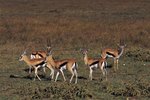
Although famous in song, the North American antelope that makes its home on the range is not really an antelope at all. The pronghorn is the only remaining member of the family Antilocapridae, a group that included almost a dozen species millions of years ago. There are as many as one million pronghorns today in North America, after conservation efforts and strict hunting limits brought them back from just 13,000 animals in 1920.
Pronghorns: America's "Antelope"
The pronghorn is unique and is more similar to a giraffe than to traditional antelope species, such as eland and gazelles. Their natural range originally ran from southern Canada to northern Mexico, and they're most commonly found in the United States now. The largest populations can be found in the Red Desert of Wyoming and in the Yellowstone ecosystem. Other populations are in northeast California, Montana, Colorado, New Mexico, Arizona, the Great Plains and parts of Oregon.
Habitat
Pronghorns prefer open, expansive terrain at between 3,000- and 6,000-foot-high elevations. Herbivores, their diet includes grasses, sagebrush and other vegetation, so they go where the food is, which often changes according to season. Season also affects herd size, which are usually separated in smaller groups according to gender during the summer months. In the winter, there's more co-mingling among gender and age, and the herds can grow to hundreds of pronghorns.
American Marathoners
Pronghorns migrate according to their need for food, so some stay put for the winter months. A 2010 Bio Science report noted a study of pronghorn in Idaho migrating 80 miles east from the Pioneer Mountains, followed by a turn north to the Beaverhead Mountains. Wyoming pronghorns, from Grand Teton National Park, undertake a migration twice as long as the Idaho pronghorns. When snow begins falling in November, pronghorn herds begin moving across private land and ranches, as well as government-owned property. The 150-mile trek is the longest land migration in the continental U.S.
Perilous Paths
The Wyoming migration is a grueling trip for the pronghorns, and they often complete the trip in several days. The trip to the Upper Green River Valley has many obstacles, including coyotes and other predators, traffic and bottlenecks. Oil and gas developments, as well as new housing developments, are obstacles blocking their route. In places where highways and development have cut across the migration route, wildlife biologists sometimes direct traffic to allow the pronghorn to pass through highway crossings. Ranchers erect fences to keep wildlife out, providing a barrier to pronghorns who can't jump higher than three feet.
Migration Continues
If migrating pronghorns successfully run the natural and developmental gauntlet in their migration, they'll pass the winter in their temporary homes. The Wyoming pronghorn will return to the greener pastures in Grand Teton National Park in the spring. Each time they encounter new fencing, roads, housing developments or traffic, there's potential for their migration pattern to be disrupted. Local organizations, government agencies and nonprofits such as the National Wildlife Federation work to create corridors for pronghorn and other migratory animals to ensure nature continues to run its course.
References
- National Geographic: Rallying to Protect U.S. Antelope Migration Route
- National Parks Conservation Association: Preserving Antelope Migration in Grand Teton
- Bio Source: A Narrow Path for Pronghorns
- National Wildlife Federation: Pronghorn
- Smithsonian: End of the Road?
- Nature Works: Pronghorn - Antilocapra Americana
- Montana Outdoors: Pronghorn in Motion
- Wildlife Conservation Society: New Long Distance Migration Route for Pronghorn Found in Idaho by WCS and Lava Lake Institute
Resources
Photo Credits
-
Tom Brakefield/Stockbyte/Getty Images




